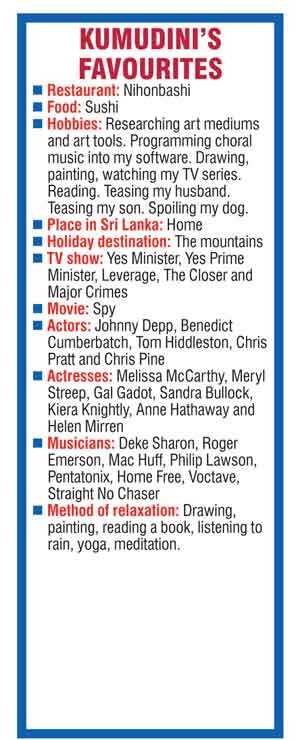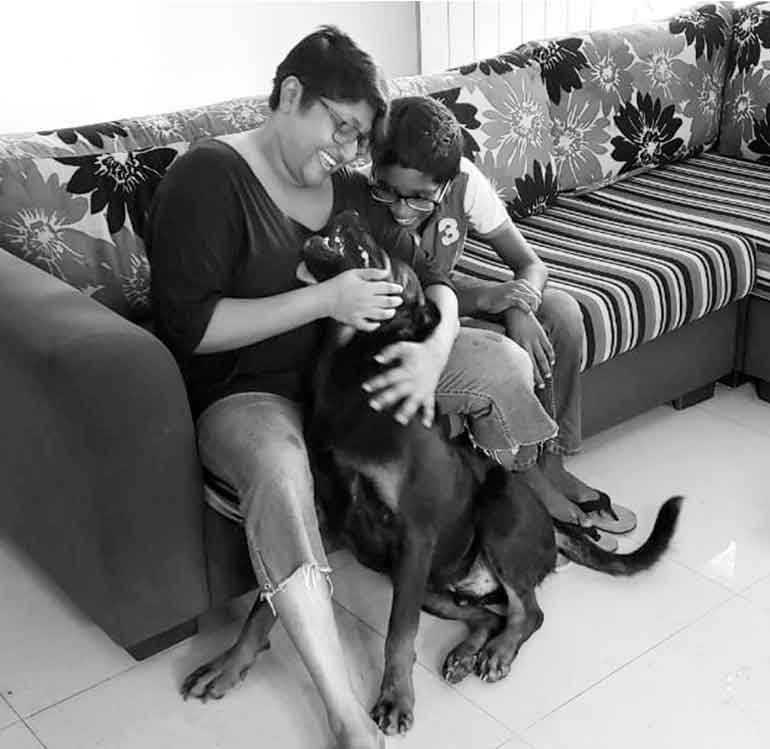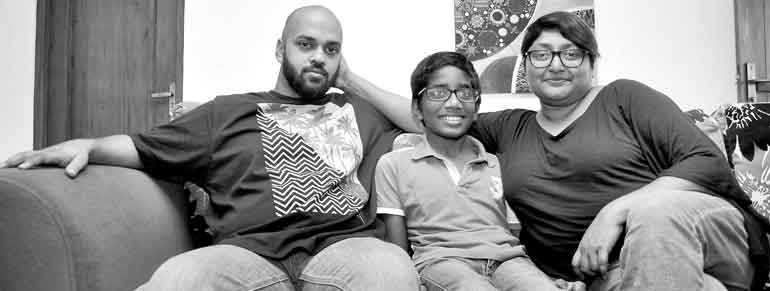Tuesday Dec 23, 2025
Tuesday Dec 23, 2025
Saturday, 26 May 2018 00:55 - - {{hitsCtrl.values.hits}}
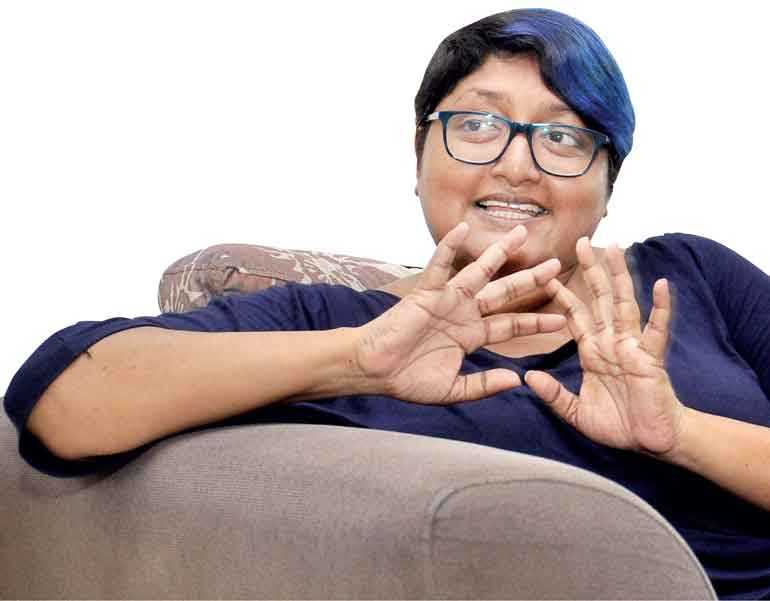

Sensational songstress, vocal trainer, artist and actress Kumudini David is a woman I deeply admire, not only for her amazing abilities and what she’s done with them, but also as a survivor and a great source of strength to those who have been subject to child sexual abuse and battled depression. Her generosity of spirit in giving of herself is deeply inspiring and her gut-wrenching honesty when speaking of her experiences – often at great emotional cost to herself – is an eye-opener to all of us. This is a woman worth watching, a woman worth emulating. Here, The Watch List shares her story
Q: Tell me about yourself – what you do, your family, your career and so on?
A: Hmm. That’s an interesting question. Let’s see. I am a mother, a wife, a daughter, a sister, a dog owner, a homemaker, a teacher, a student, a vocal trainer, a choral director, a public speaker, a vocalist, an actress, a chorister, a multi-medium artist, a women’s rights activist and a child rights activist. These are all roles that I think of as my careers (some of them I even get paid for!). What do I do? I do everything I can to serve these roles to the best of my abilities whilst maintaining a sense of self, keeping an open, inquisitive mind and a healthy somewhat-offbeat-a-lot-off-colour sense of humour.
My husband, Rashmi, is my rock, my partner and the one I turn to when I need to shed my roles and just be me. He understands my quirky sense of humour and I giggle only with him. He’s also the one who sees the tears and the fear when I am overwhelmed and the one who calms me down and gives me strength to get up and keep moving.
My son, Matthew, is a teenager with all the drama that goes with the phase and an avid gamer, much to my eternal annoyance. He’s also a kind, thoughtful and imaginative young man with more artistry in his little finger that I will ever have. He’s a drummer, a guitarist, a beat boxer and an amazing artist...so far. Watching him blossom and discover himself is one of my greatest joys. My four-legged son, Roy, is an 80lb+ cuddle-monkey who thinks I’m a very comfortable pillow.
My parents, my mother-in-law, my sisters and my cousins are my safety nets and my cheerleaders. They have been with me and supported me through thick and thin and I love them all.
I count my sisters in Camerati, the all-female vocal ensemble I’m a member of, and my students as part of my family. I learn from them as much as they learn from me, I hope.
Q: Your academic and professional background is extremely diverse, comprising psychology, multimedia realism art, strategic consultancy, consumer insights, business management, information technology, and vocal technique. What drove you to be involved in all these areas?
A: I have an overwhelming drive to understand and see the bigger picture in everything I do. I need to know how something works and how my role influences the bigger picture, to perform my role properly. It’s a personality quirk and I drove myself nuts trying to understand why I’m like this. Then SEALA 5 came to the rescue.
SEALA is the South East Asian Leadership Academy held every year. This year it was held in Sri Lanka and I was extremely privileged to be invited to participate. I found out that I am motivated to anticipate the future and be a catalyst for change whilst maintaining stability. That pretty much describes how I think.
For eight years of my life, Stax was my home. It’s a strategic consultancy firm and an absolutely brilliant place to learn, grow, and become a master at juggling roles and a jack of all trades. It was one of my schools of hard knocks. Strategic consultancy, consumer insights, business management, information technology and psychology are the fields I dealt in and what I ate and breathed. It’s also where I met my husband.
Mary Anne David’s school of Vocal Music was my other home and other school of hard knocks. Aunty Mary Anne is my second mother and the one who helped me come out of my shell. She is the best vocal trainer in the country and to learn from her, and the late great Mr. Andrew David, one must be completely focused, disciplined and eager to learn because she has so much to teach. I will continue to be a student of hers till I pass on I imagine.
Art was my escape. It’s where I let go and direct all my emotions at. However, I get bored with using only one medium. As I said I’m inquisitive so I started researching all the other mediums out there and discovered there are media not used or available in Sri Lanka that suited me much belter. So I taught myself about them and how to use them. I also discovered that if you know how to do it, properly mixed media creations yield fantastic results.
Q: Could you trace the journey that brought you to where you are now in terms of being a sensational singer and a highly-in-demand vocal trainer?
A: I started singing when I was 19 years old. Before that I only sang in the toilet or in the school choir but singing wasn’t a part of my life. It was just something I did and I was very self-conscious about. My father had heard me singing in the toilet and enrolled my younger sister and me with Aunty Mary Anne without telling us. We went for her audition; I got selected for the senior choir (my sister for the junior choir) and there began my journey in vocal music.
Now that I teach I’ve realised that a vocal trainer is, essentially, a life coach. Singing is so much more than words and notes. It is giving life to a moment, a sentiment, a message encapsulated in those words, notes and patterns in a song. To give it life the performer must understand, internalise and absorb it, making it a part of the performer. My job as the vocal trainer is not just to teach the performer the notes and patterns and technical aspects of performing the song. I must help them relate to the song, absorb it and give of themselves to the song and the audience. To do this they must understand themselves very well. This is the life coach part of the job. This is what I learned from Aunty Mary Anne and she sets the standard to which I adhere to.
When I started with Aunty I had just started acknowledging that I was sexually abused as a child and that maybe I need help. There were a lot of myself that was hidden behind mental barriers I had erected to protect myself from pain. Although Aunty didn’t know it at the time, she forced me to face a lot of my fears and pain, and she helped me to harness the emotion. She helped me exorcise some of the pain by letting it out in song. These days there isn’t much I need to exorcise but the practice of emoting I carry with me always. Emotion is a fantastic tool. Used with intelligence and rational thought it is a powerful tool for positive growth.
I am not a fantastic singer and by no means am I an exceptional performer. But I am a sensational one and that’s because I feel everything I perform and I give everything I have when I’m on stage. That is the gift Aunty Mary Anne gave me and what I impart to my students.
I have been singing for over 20 years, as a soloist and as a member of various ensembles and choirs. I direct three choirs and a number of vocal ensembles, as well as soloists. I work with both male and female voices/ensembles and I’m not genre specific. I have students focussing from Classical to Rock. Singing is a full body and mind activity where the instrument is your whole body, not just your voice. My job is to bring your instrument to optimal level and help you to do whatever you want with it.
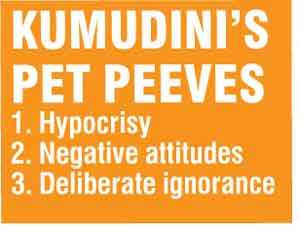 Q: You are also an artist. How did you venture into art and what does your life as an artist encompass?
Q: You are also an artist. How did you venture into art and what does your life as an artist encompass?
A: As I mentioned before, art is my escape, literally. I have a dedicated art room at home where I am surrounded by my tools, materials, mediums, colours and books. This is where I retreat to when I want to create. I love colour. I love playing with it and surrounding myself with as much colour as I can (e.g., my hair). My musical side and my artistic side are very co-dependent. When I hear a piece of music I see the patterns and emotion in colour and texture.
I have two artistic personas. I am a realism artist, which is where most of my commissioned work is concentrated. I also have my abstract range, which is where I play. Both sides are extremely important for me as they serve different needs. Realism demands details, control and perfection. This stabilises me. Abstract seeks only to represent reality; using shapes, colours, and textures. This gives me an avenue for my catalyst side to experiment with alternate and supposed realities.
Q: Could you tell us about your life on stage as an actress, yet another area you’ve excelled in?
A: The Work Shop Players and, later on, Theatre Junction are production companies that I joined for fun but they’ve become an integral part of my life. They allow me to let my diva and my crazy out and be applauded for it. They are an exceptional bunch of artists and very dear to me and they enrich my life no end. Jerome De Silva, Surein de S. Wijeyeratne, Shanuki de Alwis, Anushka Senanayake and Natasha Senanayake, I’ve learnt so much from you all. My journey in theatre started with the first ‘Phantom of the Opera’ performance WSP put on in 2012. It’s been a labour of love since then.
I love evil woman roles and crazy woman roles. I really love evil crazy woman roles. They’re so freeing. I can’t play a damsel in distress to save my soul. I can do oh-woe-is-me roles but I’m not a big fan. Woe is exhausting. Wise woman roles are a breeze.
I love the stage. I love performing. But it doesn’t pay the bills, at all. English theatre in this country is fuelled by devotion and dedication, period. At least 98% of us do not get paid for our performance which means we bear the cost of the audience’s enjoyment. Months of rehearsal, travelling from practice and back, food, and sometimes costume costs to put on well-lauded shows. But we, the actors, bear that cost. Sri Lankan corporates still do not think supporting Sri Lankan artists is a worthwhile investment. But then they pay 7k, at least, and sponsor in millions to go watch foreign performers who do get paid for what they do. A tad hypocritical, noh?
I’d also like to take this opportunity to point out to all you corporate moguls out there that there is a very strong and positive correlation between well-honed critical thinking skills and art. Artists have both lobes firing very well. You want critical thinkers? Hire people who invest in their creative side. And please sponsor their creative efforts. It will reflect very well on you and pay off in the long run. I promise.
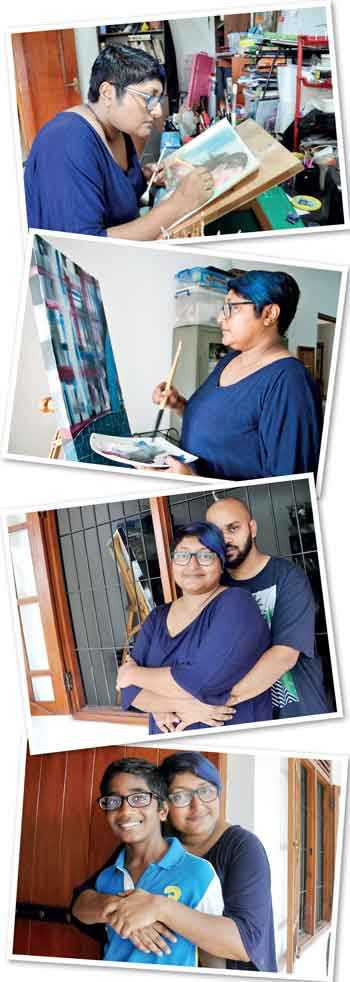 Q: You are a great source of strength and inspiration to many in how you’ve not only survived child sexual abuse but gone on to find the willingness and courage to speak about it widely in an attempt to keep other children safe. What pushed you to do so and how would you describe the experience?
Q: You are a great source of strength and inspiration to many in how you’ve not only survived child sexual abuse but gone on to find the willingness and courage to speak about it widely in an attempt to keep other children safe. What pushed you to do so and how would you describe the experience?
A: Being sexually abused as a child affected my whole life. Not because I wanted it to. It just did. I was used from age three to almost age eight, at which point I stopped going when he called. That last part, stopped going when he called, is very important to me and a memory I hold on to very dearly because that was the moment I started taking control of my body and owning it. A lot of survivors, of any type of abuse, do not have a memory like that to hold on to. The loss of control and the sense of isolation is the hardest to bear, for all of us.
I became inordinately stubborn, angry. And full of self-loathing. I was an impossible child, always at odds with my parents. The anger and self-loathing I have let go. The stubbornness I still have. I still refuse to let anything or anyone control me or make decisions for me. I will remain a stubborn old goat till the day die, and quite possibly beyond that. Being a survivor of abuse doesn’t mean bad things stop happening to you. I’ve been through quite a lot in my almost 40 years on this rock but that stubbornness kept me from caving in and giving up. There are many people I’ve been told who have wanted to beat the heads against a wall having faced my stubborn side.
I was in survival mode for most of my life. And then I met my husband, Rashmi. He’s the first person in my life who didn’t ask me to hide my past. He accepted me as I am, baggage and all. It’s from him that I found the strength to start living; not just survive from day to day, year to year. Once I came out of my bubble, I realised I was still a part of the child sexual abuse problem. If the survivors don’t talk, how will the world know there is a problem? And if all survivors assume others will talk so they won’t have to, how will the world know how big a problem it is? This applies to all types of abuse. With child sexual abuse especially, it is very important the older survivors talk because children can’t process what’s happening to them. Most children do not have the vocabulary to describe what’s happening to them, physically and mentally. They are so very vulnerable.
Around the same time I was coming out of my shell I read a tiny little article in the papers (April 2013) about seven-year-old Pushpakumar who was raped, strangled with his school tie and left naked and abandoned in an old house. I can’t tell you how hard that boy’s plight hit me. I’ve been so caught up with myself and the wellbeing off my child that I hadn’t realised other children are being humiliated, abused, raped, tortured, mutilated, sold, and/or murdered…and worse…wishing they were dead. My entire sense of purpose changed that day. I want to stop violence against children and child sexual abuse.
Q: How can we best protect our children, what steps should parents take compulsorily?
A: Once I started advocating I realised how prevalent CSA (Child Sexual Abuse) is. In some rural communities in Sri Lanka incest is considered normal. I once met a young woman who has four children; two from her father, one from her brother and one from a man who had raped her on the street after she was kicked out of her home by her sister-in-law because she was jealous of the brother raping the girl. The young woman was in her early 20s. She put her kids in foster care as she couldn’t look after all of them.
I work with a lot of good people and organisations working tirelessly to address the issue; LEADS (www.leads.lk), The Child Protection Force (www.childprotectionforce.org), RURI (www.rurifoundation.org), Shanthi Maargam (www.facebook.com/ShanthiMaargamSL) and Samutthana (www.samutthana.org.lk), to name a few. We’re still chipping away at the tip of the iceberg.
There is one aspect of CSA that I feel are not being addressed in Sri Lanka. Support for survivors of abuse. The entire structure in Sri Lanka at addressing CSA is punitive, not supportive. This is for predator and survivor alike. The vicious cycle of abuse is not addressed. I feel it is vital to address it to reduce CSA as it has been proven that most abusers had been victimised at some point in their lives. Let me try and help you visualise the scope of CSA and how many facets of it need to be addressed at the same time to make an impact.
A groomed child: A predator will befriend the child and gain the child’s trust. He/she will make the child comfortable with his/her touch and get the child to keep secrets.
Ephebophile: An adult who is sexually attracted to adolescents.
Paedophile: An adult who is sexually attracted to children.
Every child has the right to expect to be protected, by all of us. What I list below is easily found with a quick Google search:
The biggest mistake we make when devising our nets of protection for our little ones is not considering the danger from within our circles of trusted people.
97% of victims know their abuser.
No one gets up one morning and thinks: “Hmmm...Let me try molesting a child today.” Paedophiles can’t help themselves. Most of them know it is wrong and actively try to fight it, will stay a paedosexual, and some will live out their lives without touching a child. Unfortunately they don’t have a support structure either. Many will not get the help they need before it’s too late.
It’s important to note that they can get help without prejudice if they ask for it BEFORE touching a child.
There are male AND female paedophiles.
Does this mean no one is above suspicion? Unfortunately, yes. Look carefully at all of them.
Your biggest indicators of danger will come from your child. Paedophiles have a high degree of self-preservation. They know they have a deep dark secret they need to hide and will go to many lengths to hide it.
Listen to your children. Not just to the words from their mouths. But most particularly from what they don’t say. Look at their behaviour and how they treat themselves.
Red flags to watch are:
Changes in behaviour — such as aggression, anger, hostility or hyperactivity — or changes in school performance
Frequent absences from school or reluctance to ride the school bus/van
Reluctance to leave school activities, as if he or she doesn’t want to go home
Rebellious or defiant behaviour
Find it difficult to develop or maintain close personal relationships.
Have a strong desire to live in isolation or to “hide out” from life.
Endure physical ailments like neck, back, stomach and gynaecological problems that persist despite efforts at good self-care.
Experience feelings of sadness, fear and anger that often seem unmanageable or overwhelming.
Undergo panics, rages, depressions, sleep disorders, or self-mutilation or have suicidal thoughts.
Find themselves depending on alcohol, other drugs, or may develop eating disorders to cover feelings of humiliation, shame and low self-esteem.
Exhibit signs of trauma like panic attacks, numbing of body areas, and feeling of being disconnected from their bodies.
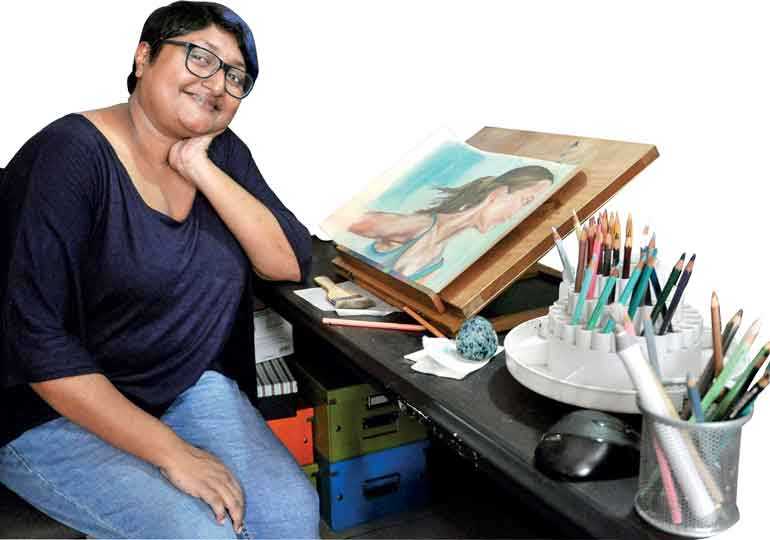
Attempts at running away Attempts at suicide
Talk to your children about sexuality and sexual abuse in age-appropriate terms:
Talking openly and directly about sexuality teaches children that it is okay to talk to you when they have questions.
Teach children the names of their body parts so that they have the language to ask questions and express concerns about those body parts.
Teach children that some parts of their body are private.
Let children know that other people should not be touching or looking at their private parts unless they need to touch them to provide care. If someone does need to touch them in those private areas, a parent or a trusted caregiver should be there too.
Tell children that if someone tries to touch those private areas or wants to look at them, or if someone tries to show the child their own private parts, they should tell a trusted adult as soon as possible.
All children should be told that it’s okay to say “no” to touches that make them uncomfortable or if someone is touching them in ways that make them uncomfortable and that they should tell a trusted adult as soon as possible.
This can lead to some slightly embarrassing situations, such as a child who then says they don’t want give a relative a hug or kiss! Work with your child to find ways to greet people that don’t involve uncomfortable kinds of touch.
Talking openly about sexuality and sexual abuse also teaches children that these things don’t need to be “secret”.
Abusers will sometimes tell a child that the abuse is a secret (it happened to me). Let your children know that if someone is touching them or talking to them in ways that make them uncomfortable, it shouldn’t stay a secret.
Make sure to tell your child that that they will not get into trouble if they tell you this kind of secret.
Don’t try to put all this information into one big “talk” about sex.
Talking about sexuality and sexual abuse should be routine conversations.
Be involved in your child’s life:
Be interested in your child’s activities.
Ask your child about the people they go to school with or play with.
If your child is involved in sports, go to games and practices. Get to know the other parents and coaches.
If your child is involved in afterschool activities or day-care, ask them what they did during the day.
Games (for example, Grand Theft Auto) allow the user to engage in sexual violence.
Use examples from TV or games that you have watched or played together to start up conversations about sexuality and sexual abuse.
Be available:
Make time to spend with your child.
Let your child know that they can come to you if they have questions or if someone is talking to them in a way that makes them feel uncomfortable.
Be sure to follow up on this! If your child comes to you with concerns or questions, make time to talk to them.
Q: Child sexual abuse survivors also battle depression and PTSD. Could you talk about your experience and survival strategies?
A: I’ve been battling depression all my life but I wasn’t diagnosed until 2015. Battling depression is like dragging yourself through very deep mud to get out of your house every morning. It sucks the life out of you. I tried to manage it by myself. I used my singing and my art to help me drag myself out of the pit but I kept getting dragged back in. It was a constant struggle.
Then in 2015 I decided I had enough of feeling like my life was constant misery and I presented myself for treatment. It’s an ongoing process and I have trained myself now not to catastrophise (think of the worst possible scenario). I can’t tell you how good it feels to want to get up in the morning and not feel like I have shackles dragging behind me everywhere I go.
Q: What is your message to survivors of abuse and depression?
A: I recently posted a visual aid on FB to help people identify if they were suffering from anxiety as it showed the various symptoms of anxiety. I got responses from a few saying they have all of the symptoms but that was normal for the average 21st century individual. No, it’s not normal. Don’t mistake prevalence for normal. It is very sad that people will put up with experiencing panic attacks, hyperventilation and heart palpitations without getting help. A lot of these symptoms occur for those who suffer from Post-Traumatic Stress Disorder as well.
My husband helped me through the process of recovery. It’s scary to face alone. Having the support of your loved ones is very helpful, and it feels really good, but it’s not a must have to go get help. The decision to get help was mine. Coming to the realisation that you need help and making the decision to get help is the biggest part of your recovery.
You are not alone, my friends. There are many of us out there. Take a breath, reach out. Help will be at hand.
Q: What’s a day in your life like today?
A: Goodness... Well, I run a house so I attend to house chores. I try to manage my teenage son’s various academic and extracurricular needs. I have a very needy, slightly homicidal dog that needs to be looked after. That’s a daily view.
Apart from the above, I prepare for my various vocal training classes that all have their own learning curve. The same goes for the choirs I direct. I sing with five wedding choirs so I usually have a wedding coming up. I sing with the Camerati and the Arpeggios, both professional choirs. The Camerati are an all-female vocal ensemble. The Arpeggios is a mixed-voice ensemble.
The Camerati are very close to my heart. It’s here I put the most of myself as a chorister and singer. We are 11 ladies who like to challenge ourselves to perform pieces that are outside our comfort zone. We are all perfectionists so we drive ourselves nuts but we have fun on the journey. We have a few exciting programs lined up that we are working on.
I have commissioned art work I need to get done on deadline and personal projects I’m working on in order to put on an exhibition, so that’s sorted in the night when everyone sleeps.
I’m also working on a multi-lingual survey to suss out how prevalent abuse is in Colombo, all types of abuse. The hope is that this survey can be used to get an idea on the prevalence of abuse in Sri Lanka so we have actionable statistics to work with.
Q: What inspires you?
A: My husband, my son, my sisters, my dog, my students, tea! Lots of tea! Colours, music, rain, thunderstorms, the sea, the mountains, the Camerati, my SEALA mentors, my SEALA 5 family, and my art room. Also, the TV series: Yes Minister, Yes Prime Minister, Leverage, The Closer and Major Crimes.
